Niko Arnautis is a Greek-German manager who took over Eintracht Frankfurt in July 2020 when 1. FFC Frankfurt, a record seven-time Frauen-Bundesliga champions, merged with Eintracht Frankfurt.
During his time at the club, he took them from mid-table to being consistently competing at the top with Wolfsburg and Bayern.
In 2023/24, he achieved a return to the UEFA Women’s Champions League group stages for Frankfurt, a competition which has eluded them since 2015-16 when they actually reached the semi-final. They have, in actual fact, won the Champions League on four prior occasions, so this return has been a long time coming.
In this tactical analysis, we break down how Niko Arnautis’ Frankfurt side looks to play in and out of possession. We will look at the tactics he has deployed throughout the Champions League so far this season, highlighting some strengths and areas of improvement that opponents have brought to light.
In possession
Frankfurt have demonstrated a clear intention to play out from the back. They have tended to do this through the use of centre-backs and, as a rule throughout the Champions League campaign so far this season, have looked to play around their opponent’s press rather than penetrate through the middle of the field using the midfielders. This can be seen by the diagram below, where you can see the majority of Frankfurt’s penetrating passes going through the wide channels as opposed to the middle of the field.
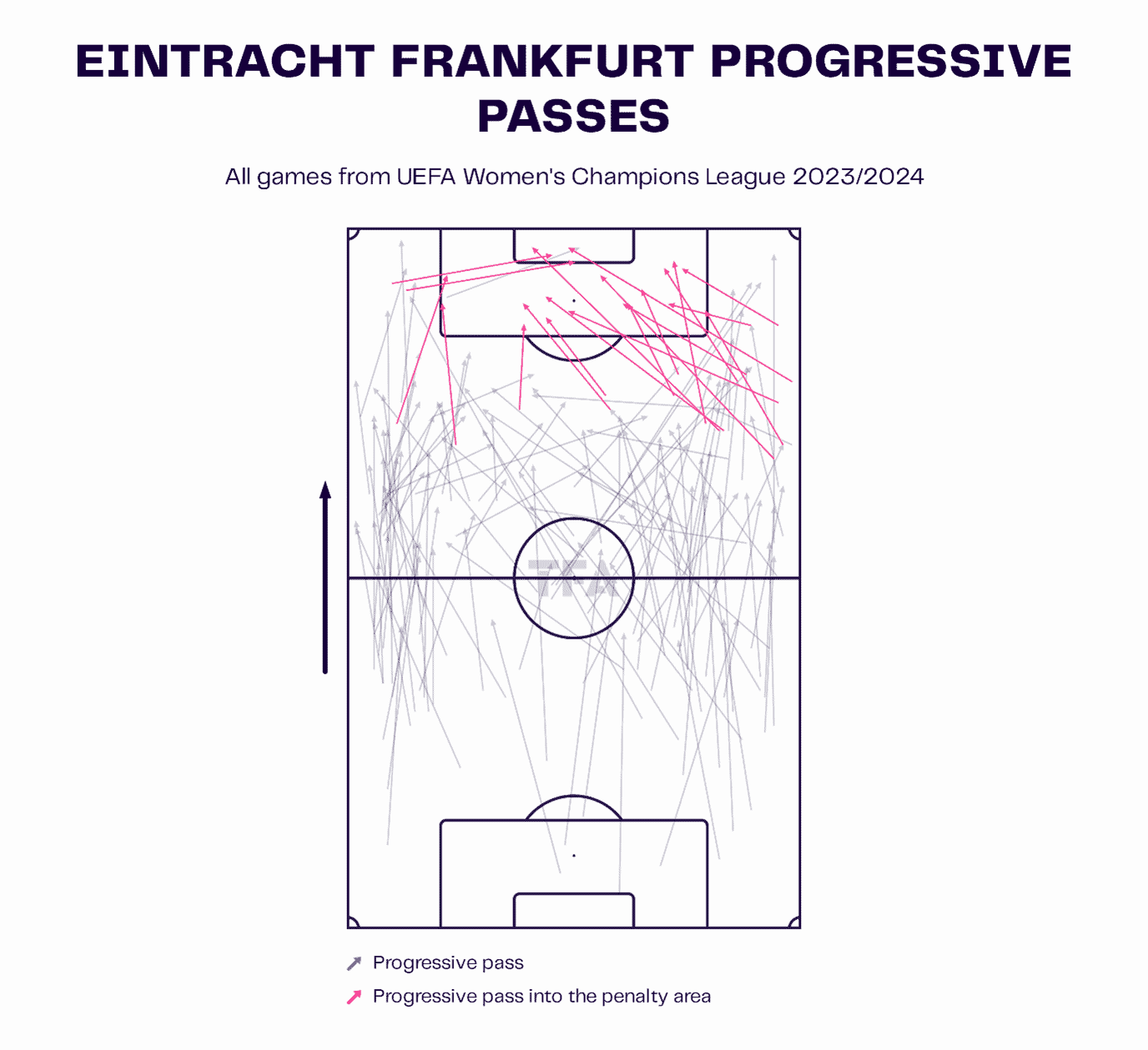
Now, let’s examine some instances of Frankfurt executing this idea. They will generally spread the centre-backs wide, then use defensive midfielder Tanja Pawollek as the sole deep pivot just in front of the back line. Meanwhile, the two full-backs will hold the width, the two central midfielders will play wider, ready to support the full-backs if the ball comes their way, and the front three will play narrow, with Laura Freigang deployed deeper as a ten with the licence to roam around the field more and try to create overloads and mismatches.
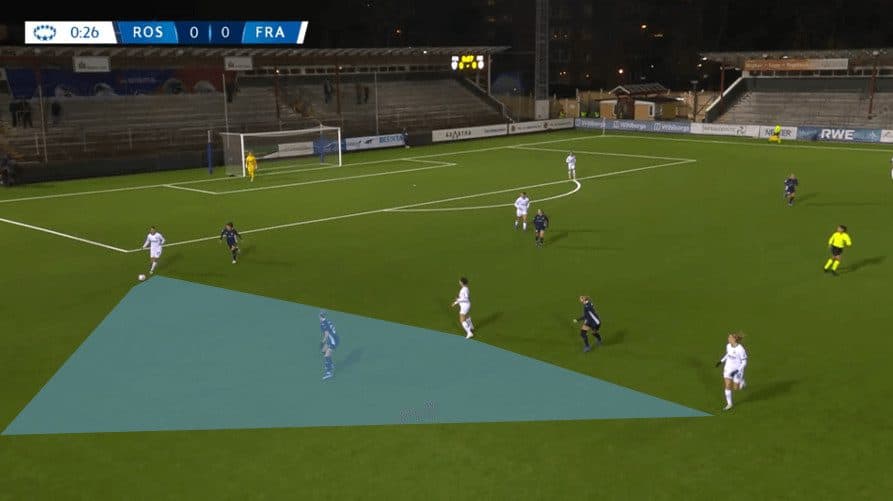
In this above example, you can see how Pawollek has dropped deeper. You can also see how Freigang has got that licence to roam, and here she is creating a 4v3 out wide with the Frankfurt right-back just out of shot.
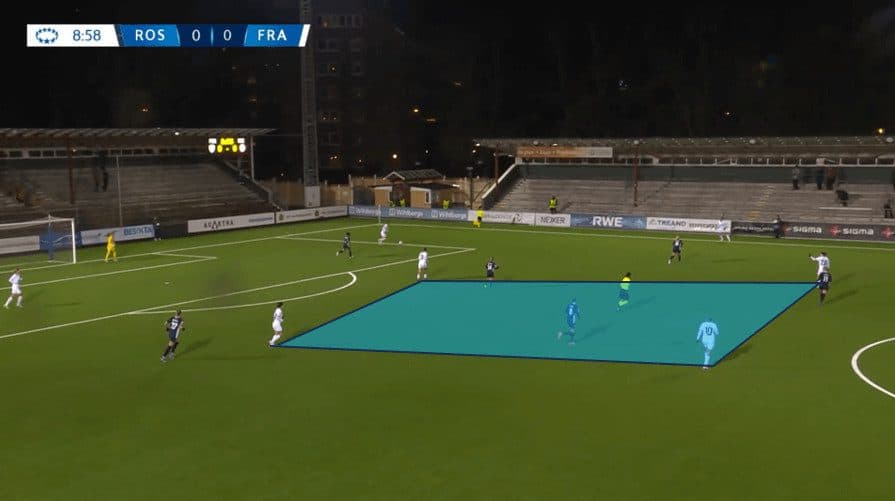
Another key alternate option that Frankfurt have used to develop play is the use of double pivots, with midfielder Géraldine Reuteler dropping deeper and Barbara Dunst pushing forward, playing in line with Freigang as both more attacking midfielders, as you can see from the image above.
The front three playing narrow is also an essential characteristic as often Frankfurt will play longer balls towards forwards Lara Prašnikar and, in particular, Nicole Anyomi, have a narrow front three with Freigang slightly deeper means that they can use her as a bounce pad to help launch and develop attacks quickly up the field, using a more direct approach.
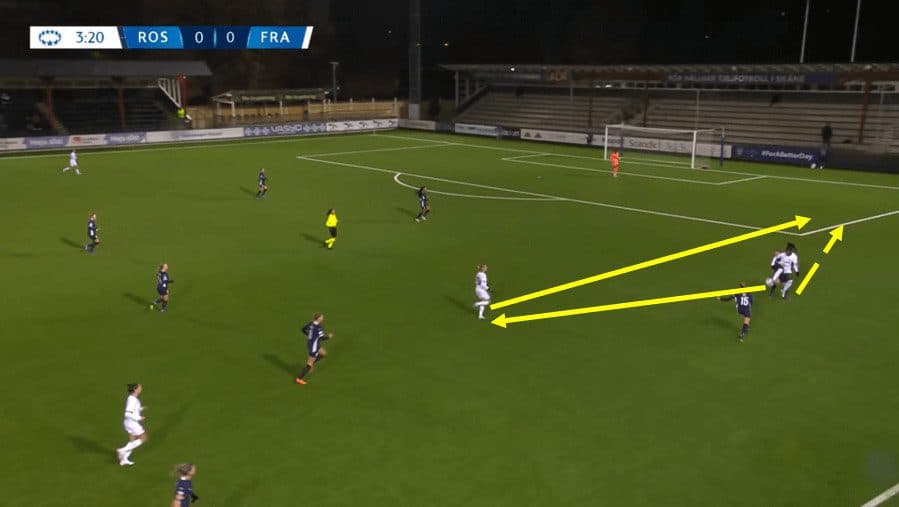
In this above example, a long ball is played towards Anyomi; she takes one touch to drop it down to Freigang before spinning behind the defence and receiving the return pass, which earns her side the corner.
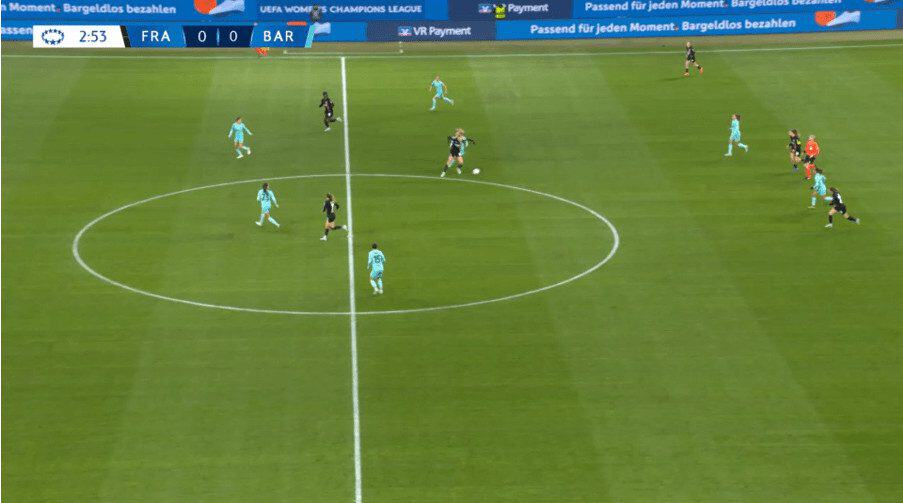
What was particularly noticeable against a side like Barcelona, who are going to press high up the field and dominate possession and territory for large spells of the game, was how Frankfurt would look to draw them up the field by passing between the backline. Then they would launch a ball towards the front three and try to target Barcelona when they were thinner for numbers. This can be seen in the picture above, where Freigang receives a long ball; Frankfurt try to get in behind the defence with Anyomi and eventually wins a corner kick from it.
When the ball has progressed further up the field, Frankfurt like to deploy a midfield diamond shape; they use this to try and support and develop attacks in wide areas without using multiple designated typical wide players. So, instead, what you get is Freigang and the two more advanced midfielders in Dunst and Reuteler drifting into the wide channels. You will also see the forwards making runs into wide channels.
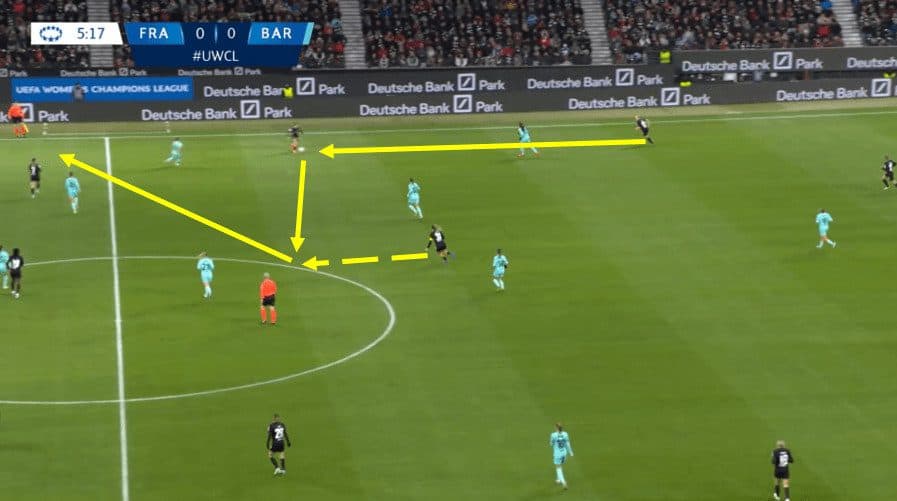
Above is an example of how they use the midfield diamond to progress the ball down the wings, with right midfielder Reuteler getting out into the wide channel to receive that ball down the line from her right-back Pia-Sophie Wolter. Then you get an excellent example of how they can use combinations to progress the ball, with Pawollek moving forward to receive the ball between the lines and play the ball forward to Prašnikar, who is left one-on-one with the full-back.
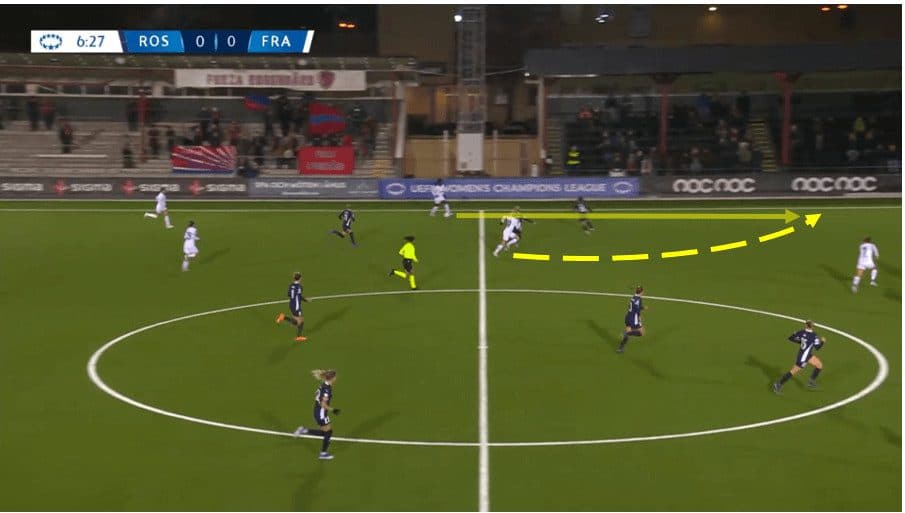
In this example, Anyomi gets outside to receive the ball from the left-back Verena Hanshaw. You then get Freigang making an arched run into the space in the wide channel to progress the ball down the line that way.
They use this wide play to aid chance creation. As previously stated, Frankfurt look to play around the press and get the ball to their full-backs. Then, when the full-backs are in these areas through combinations with the midfield diamond players or forwards, they look to get crosses into the box where they put plenty of targets for Frankfurt to aim at, often four players with midfielders advancing into the box.
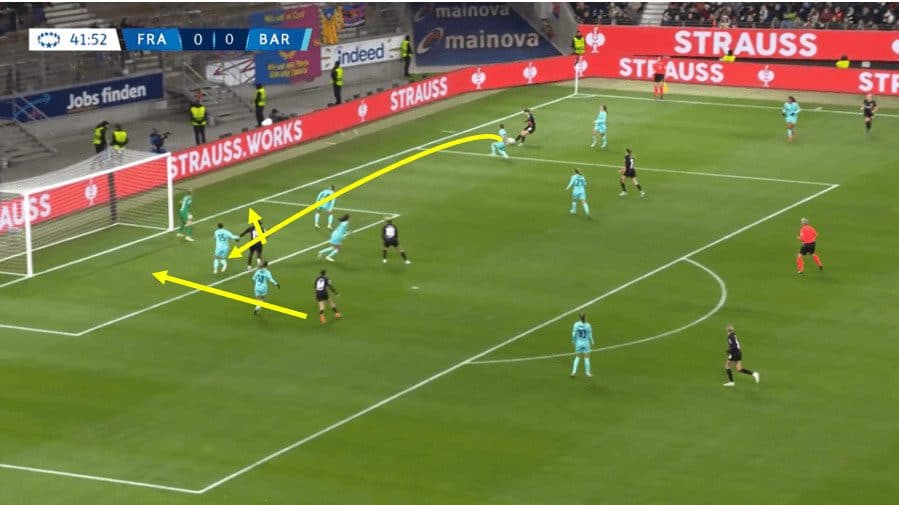
In this example, you get two back-to-back crosses, the second of which results in a goal, but here is the first cross—a ball into the box by Dunst. Frankfurt have three players in the box, and they all coordinate to separate areas. Anyomi attacks the front post, Reuteler attacks the back post, and Freigang drops back for the cutback or to react to any ricochets that may occur.
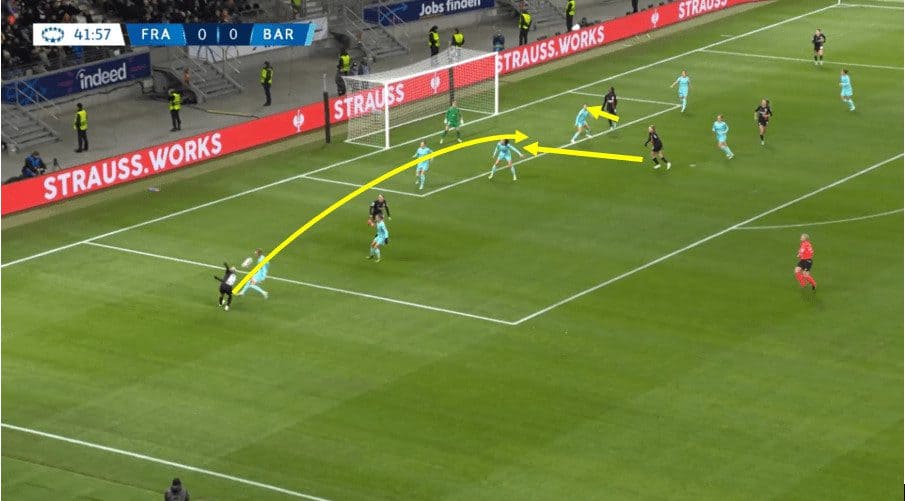
Then you have the second cross; this time, the ball is delivered in by Hanshaw, but again Frankfurt have three targets centrally, and they all attack different regions again, with Freigang attacking the front post, Anyomi the back post and this time Prašnikar dropping back for a cutback or any loose ball in the box. The ball hits Freigang, and Frankfurt takes the lead against a very strong Barcelona side.
Out of possession
In defence, Frankfurt look to match up with their opponents and try to win the ball high up the field. With the forwards in particular, Anyomi is very adept at pressing opponents and winning the ball back from where she can then launch counterattacks and often end with shots.
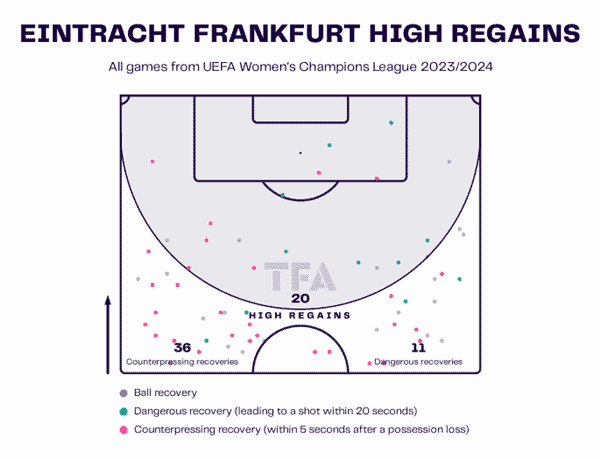
The way that Frankfurt press their opponents is by using a player-to-player marking system in the midfield, and the defence will play a high defensive line. The front three will additionally play narrow, often with Freigang marking the pivot. However, the front three are narrow because they are trying to force their opponents into wide areas. They then squeeze the spaces and are able to win the ball back with regular success.
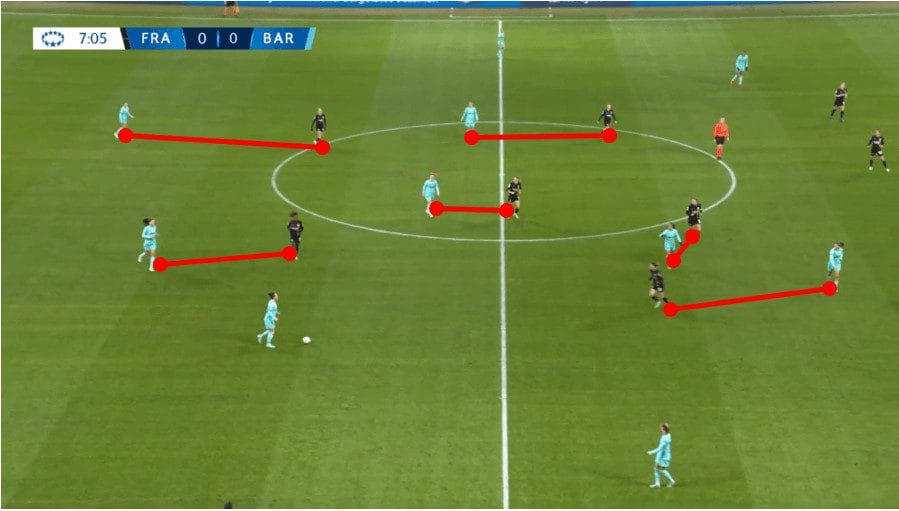
This example shows the narrow front line, with Anyomi and Prašnikar marking the centre-backs. You then have Freigang marking pivot Keira Walsh. The midfield three are then all engaged by a Barcelona player as well. The narrow and congested midfield area manipulates Barcelona to play that ball out wide.
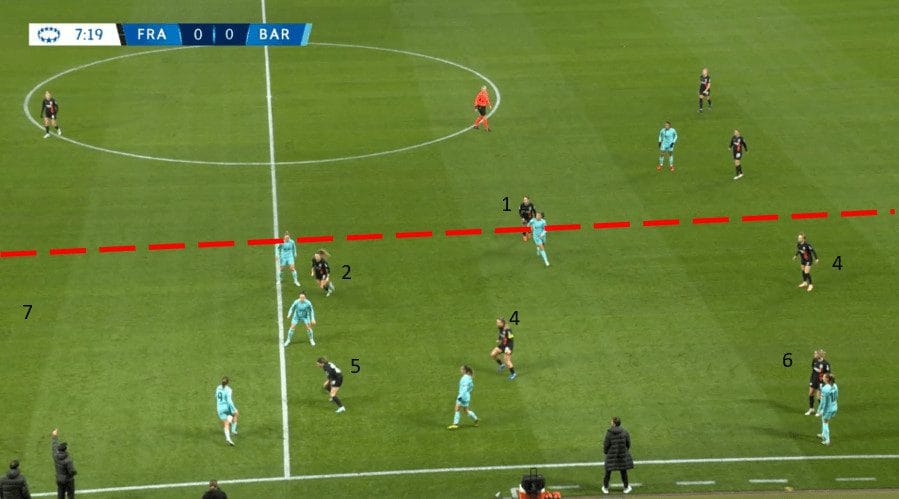
This is the same situation but rolled on for fourteen seconds. You can clearly see how Frankfurt have congested this wide space, with six Frankfurt players in this wide channel alone, giving Barcelona no room to try and play. As such, they are able to force a turnover and try to launch a counterattack.
However, several problems arise with this style of defending. Number one is in the midfield player-to-player marking idea. This often led to the three midfielders being spread far apart, particularly against a side like Barcelona, who look to stretch the width of the field. As such, the gaps opened up centrally for either a defender to drive on the ball themselves or play a penetrating pass to a forward who has a larger channel to operate in than usual to receive the ball.
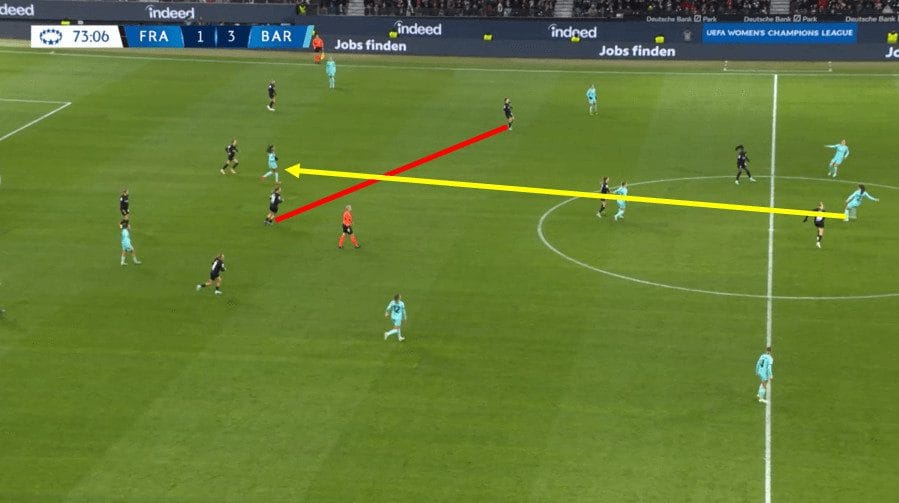
In this example, you can see how Dunst is dragged out wide to watch Aitana Bonmatí, who is playing wide. This leaves a vast disconnect between Dunst and Pawollek. Opening up this penetrating pass for Ingrid Ingrid Syrstad Engen to play into Salma Paralleulo’s feet in the meantime by passing Frankfurt’s forward and midfield lines in one pass.
A second issue that Frankfurt found with this method of defending was the use of inverted wing backs, as Benfica were able to find on several occasions. Using a similar principle as before, you are putting somebody in the gaps that open up as the midfield spreads apart.
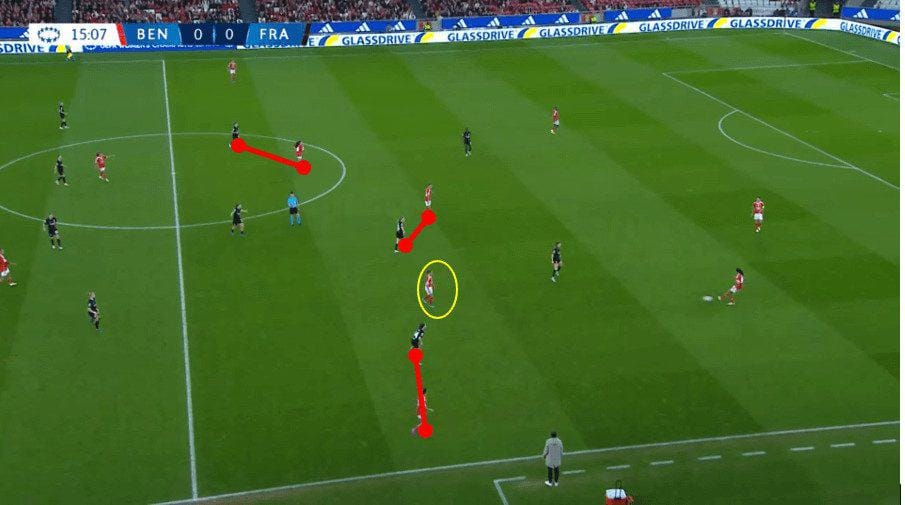
Here is an example of how Frankfurt can struggle with inverted wingbacks. Benfica generally played with three midfielders, with Freigang marking the deeper central player. Reuteler has then drifted out wide to follow Benfica’s number ten Francisca Nazareth. Meanwhile, Dunst is occupied by the midfielder on the far side. This then leaves Benfica’s left-back unmarked through the middle. This added pseudo midfielder has created real uncertainty in the Frankfurt backline.
The third issue that Frankfurt has found with this is that when they compress one side of the field to try and win the ball back, they become very vulnerable to switches of play. This can leave full-backs isolated out wide and allows teams like Barcelona to cross balls into the box.
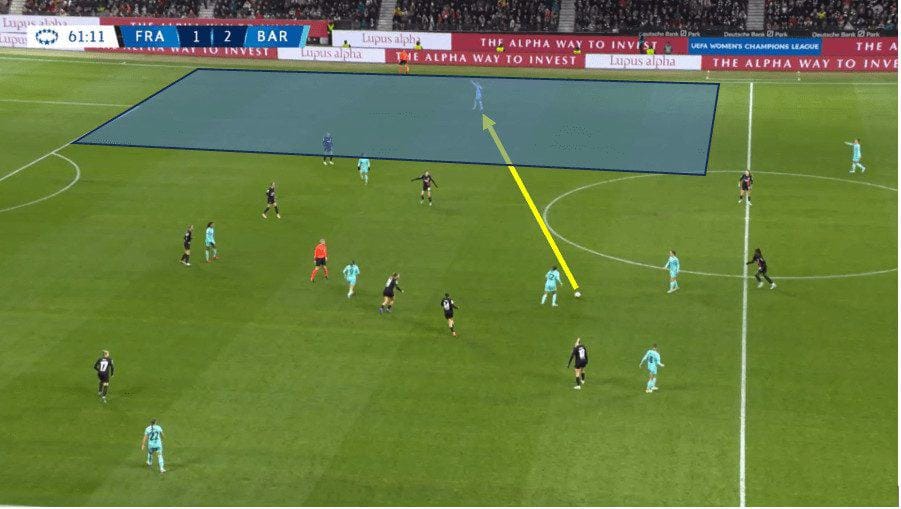
Here you can see how Frankfurt has compressed to one side of the field in order to try and compress the wide channel. However, Barcelona have been able to recycle the ball and switch the ball to the opposite flank. Note the amount of space Caroline Graham-Hansen has been left in by no means somebody you want to be isolated one-on-one with.
In addition to all these issues, the most fundamental principle of man-marking is you have to be able to win your one-on-one match, and if Frankfurt do lose one of these matchups, the aforementioned spaces will still become available. Teams can target and penetrate them in this way as well.
Transition
In the attack-defence transition phase, Frankfurt has mixed levels of success. Generally, they keep three often four players back to guard themselves from counterattacks. These players are often the two central defenders, Sophia Kleinherne and Sara Doorsoun-Khajeh. These two are often supported by Pawollek, who sits just in front of the back two. Then, often, you will have the weak side full-back playing deeper, alert to counterattacks.
They have good levels of success at preventing these counterattacks from developing, with one centre-back often stepping up to try and delay and slow down any counterattacks. At the same time, the other covers any balls in behind. Both central defenders have good levels of speed, so they are comfortable playing this role. However, on several occasions, weak or awkwardly dealt with balls could have led to chances; if one defender made a mistake, the other would often mop it up. The two centre-backs worked really nicely in tandem.
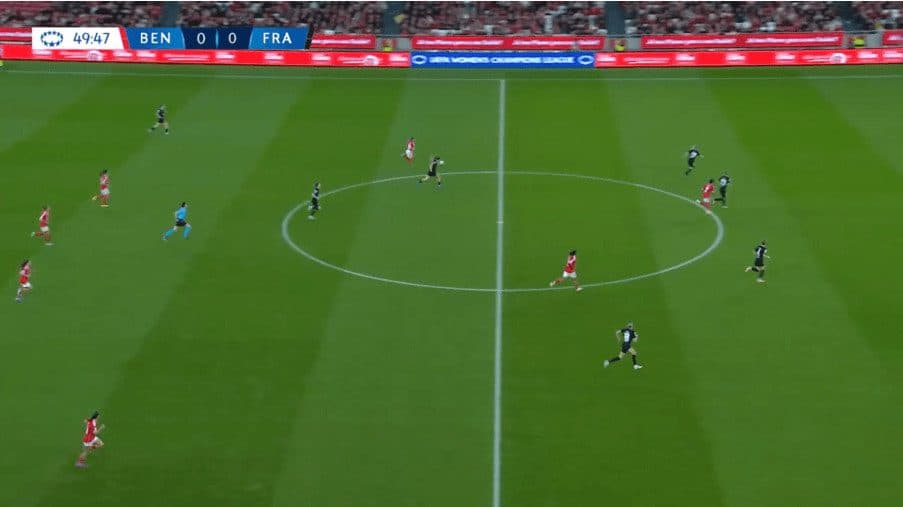
In this example, you can see the deep shape with Pawollek covering just in front of the Frankfurt backline, all of which are behind the ball, giving the numbers superiority to the Frankfurt side. The only way that Benfica can realistically score is by beating Frankfurt players one-on-one.
In the defence-attack transition phase, the majority of the time, Frankfurt looked to get the ball up the field quickly, playing balls into one of the front three’s feet. Then, once the balls were with these players, they would look to push forward in numbers, and the off the ball movement here was of a high level, and they were able to take advantage of the stretched opposition defence several times. However, against Barcelona, who often had more players back than Frankfurt, they struggled to win one-on-one matchups and, as such, often settled for long-range low percentage shots.
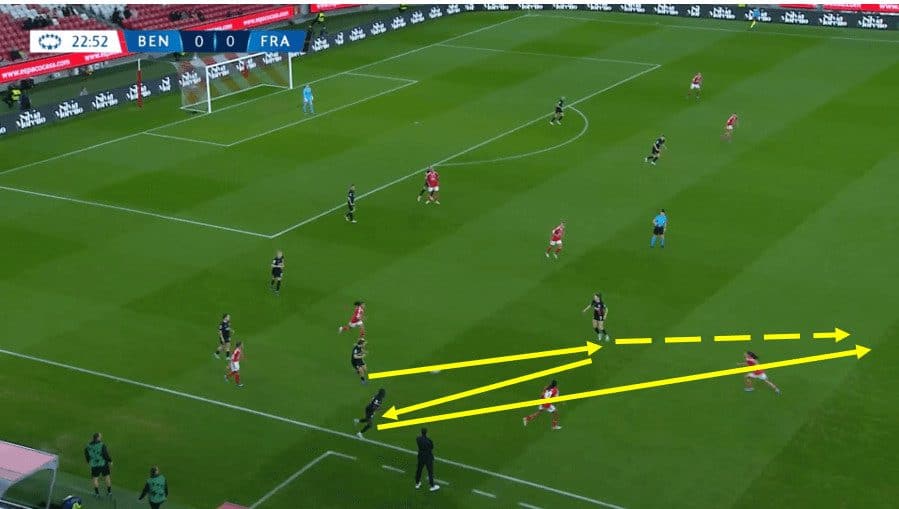
Here, Frankfurt win the ball back through Pawollek; she then quickly passes to Prašnikar, who plays a one-two with Angomi and leaves Frankfurt with a 3v3 against the Benfica backline.
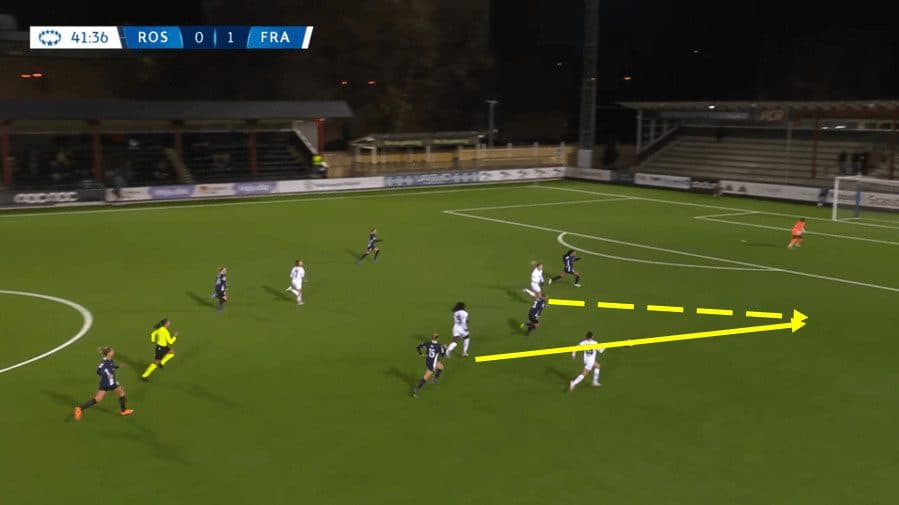
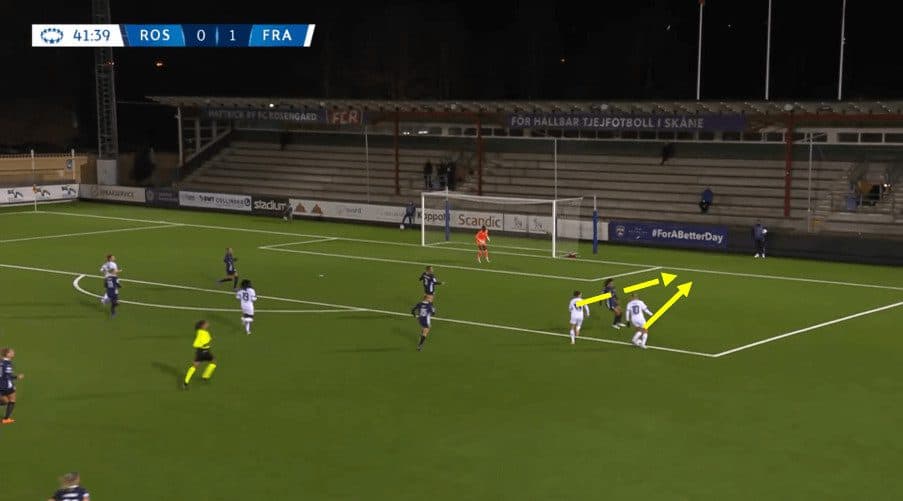
This example illustrates the sort of attacking movement that Frankfurt can deploy to really take advantage of the superiority in numbers. With Frankfurt having created a 4v3 against the Rosengård backline. Angomi is driving forwards on the ball, having won the ball back. Freigang makes this inside-out run into the wide channel. This drags the defender wide. Reuteler then makes an underlapping run to get beyond Freigang and wins a corner from a blocked cross to isolate this defender.
Although they mostly looked to play fast counterattacking football, Frankfurt also demonstrated some ability to retain and recycle possession coming out of the defence-attack transition. This was particularly when the ball was won back deep in compressed areas of the field. They compressed the field to make things difficult for the opposition, so why would you give the opposition the upper hand doing the exact same thing? So, instead, they reset and try to switch the point of attack away from the congestion.
Conclusion
As you can see, Frankfurt have a clear identity under Niko Arnautis, which has stood them well in the Frauen-Bundesliga. However, there are certainly some things they can look to develop and build on if they are to become powerhouses of the European stage again as they once were. With lots of positives and things they will need to build on and improve, they certainly can make the knockout stages of the Champions League this season and get out of a difficult group with Barcelona, Benfica and Rosengård.

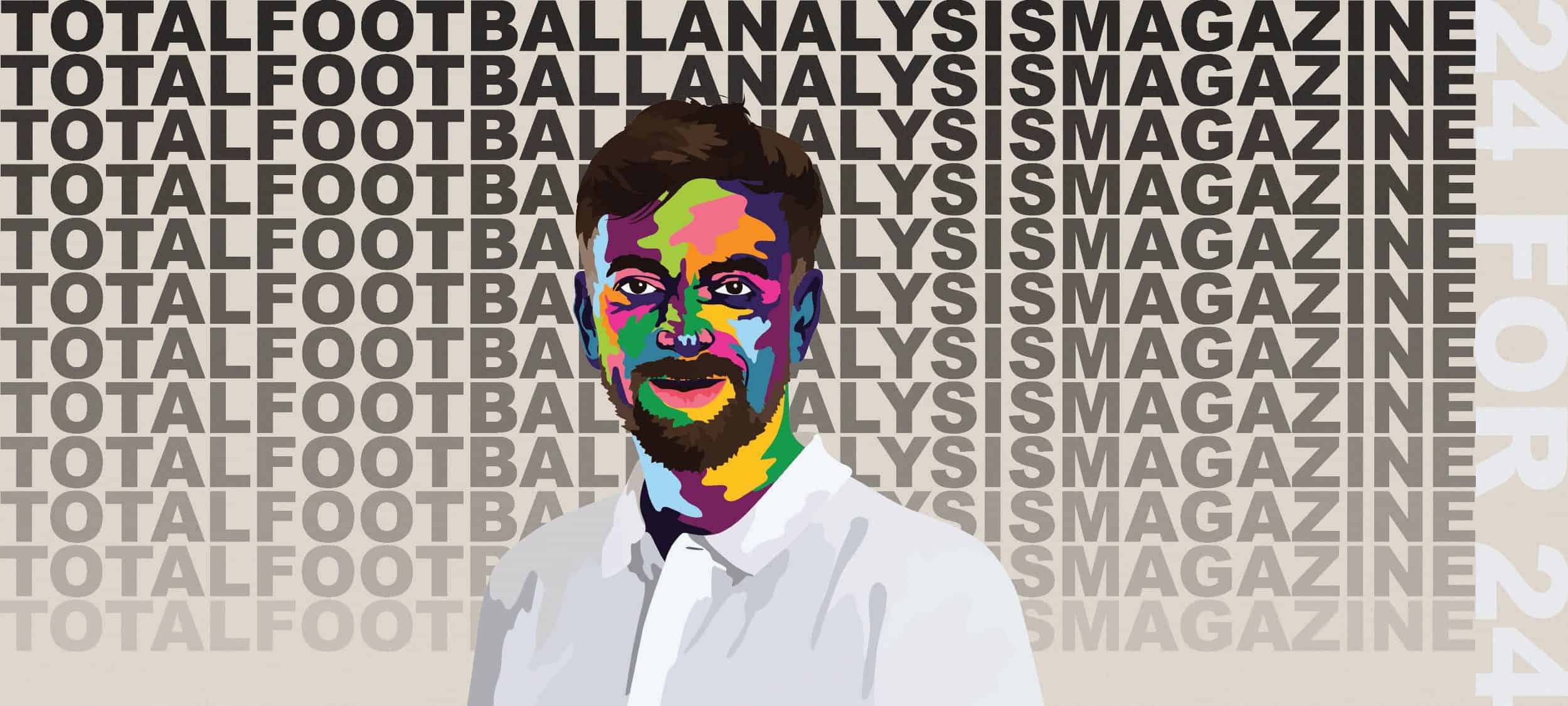




Comments